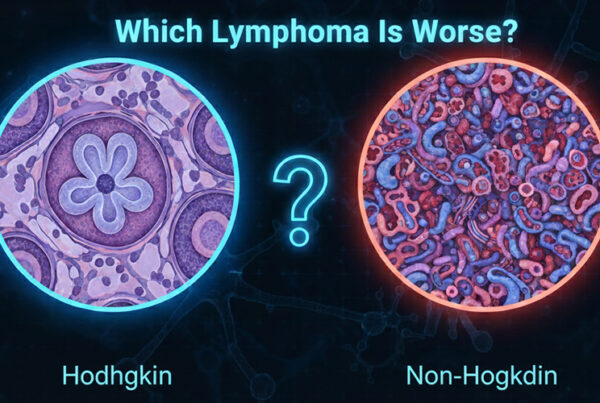
Hodgkin lymphoma is a blood cancer that begins in the lymphatic system, the network that helps your body fight infections. This system includes the lymph nodes, spleen, thymus, tonsils, adenoids, and bone marrow. When Hodgkin lymphoma develops, it usually starts in special white blood cells called B lymphocytes. It can involve lymph nodes in different parts of the body and may also reach nearby organs.
Many factors can increase the chances of developing Hodgkin lymphoma, including a family history of the disease and conditions that weaken the immune system, such as HIV/AIDS. EBV-related cases fall into a group known as Epstein–Barr virus-associated lymphoproliferative diseases. To confirm the diagnosis, doctors look for specific cancer cells called Reed–Sternberg cells through a lymph node biopsy. This test helps identify the exact type of Hodgkin lymphoma so the right treatment approach can be planned.
Types of Hodgkin lymphoma
There are two main types: classic Hodgkin lymphoma and nodular lymphocyte-predominant Hodgkin lymphoma. Classic Hodgkin lymphoma is the most common form, and in many cases, it’s linked to the Epstein–Barr virus (EBV).
Classic Hodgkin lymphoma
Classic Hodgkin lymphoma is the most common form of this cancer, and it’s known for the presence of Reed-Sternberg cells, which are large, abnormal cells found in the lymph nodes. This type has a few subtypes, including nodular sclerosing, mixed cellularity, lymphocyte-depleted, and lymphocyte-rich classic Hodgkin lymphoma.
Nodular lymphocyte-predominant Hodgkin lymphoma
Nodular lymphocyte-predominant Hodgkin lymphoma is much less common. Instead of Reed-Sternberg cells, it involves special lymphoma cells often called popcorn cells due to their shape. Many people with this type are diagnosed early, and treatment is usually less aggressive than what’s used for the classic form.
Hodgkin vs Non-Hodgkin Lymphoma
Hodgkin lymphoma and non-Hodgkin lymphoma are both cancers of the lymphatic system, but they differ in how they develop and behave. Hodgkin lymphoma is marked by the presence of Reed-Sternberg cells, which are large, abnormal B lymphocytes. Non-Hodgkin lymphoma includes a wider variety of lymphomas and usually does not have Reed-Sternberg cells.
Hodgkin lymphoma tends to follow a more predictable pattern of spreading from one lymph node group to another, whereas non-Hodgkin lymphoma can spread more unpredictably. Understanding these differences helps doctors decide on the most effective diagnosis and treatment plan.
Also Read: Which Lymphoma Is Worse? Hodgkin Or Non-Hodgkin Type
Symptoms of Hodgkin lymphoma
- Painless swollen lymph nodes, often in the neck, armpits, or groin. These may feel rubbery or firm.
- Swollen lymph nodes in the chest are sometimes seen on an X-ray.
- Persistent itchy skin
- Night sweats
- Unexplained weight loss (10% or more in six months)
- Low fever that comes and goes
- Ongoing fatigue
- Enlarged spleen
- Enlarged liver (less common)
- Both the liver and spleen are enlarged at the same time
- Pain in affected lymph nodes after drinking alcohol (rare but notable)
- Lower back pain without a clear cause
- Cyclical high fever referred to as Pel–Ebstein fever
- Kidney-related issues, such as nephrotic syndrome
- Breathing or chest problems, like airway blockage or fluid around the lungs or heart
- Liver problems or bone marrow involvement in advanced cases
What Causes Hodgkin Lymphoma to Develop
Hodgkin lymphoma begins when a white blood cell, called a lymphocyte, undergoes changes in its DNA, causing it to grow uncontrollably. These cancerous cells, known as lymphoma cells, can crowd out normal white blood cells, weakening the immune system and making it harder to fight infections.
The abnormal lymphocytes usually form masses in the lymph nodes, which are part of the lymphatic system and spread throughout the body. They can also accumulate in other areas containing lymphoid tissue, such as the spleen, liver, or bone marrow.
Hodgkin lymphoma is identified by the presence of distinctive cells called Reed-Sternberg (RS) cells and Hodgkin cells. RS cells are unusually large B lymphocytes, often with more than one nucleus, giving them an “owl-eye” appearance under a microscope. Hodgkin cells are slightly smaller but still abnormal. Detecting these cells helps doctors classify the subtype and guide treatment decisions.
Diagnosis of Hodgkin Lymphoma
Diagnosing Hodgkin lymphoma involves a combination of medical evaluation and specialized tests. Your healthcare provider will start with a thorough physical exam, checking for enlarged lymph nodes and asking about any symptoms you’ve noticed, such as unexplained fever, night sweats, or unintentional weight loss.
Blood Tests
Blood tests help assess overall health and can indicate signs of lymphoma. Common tests include:
- Complete Blood Count (CBC)
- Blood Chemistry Tests
- Inflammation Markers
- Lactate Dehydrogenase (LDH)
- Viral Tests
Imaging Tests
Imaging helps visualize the extent and location of cancer. Depending on your situation, tests may include:
- Chest X-ray
- CT scan
- PET scan
- MRI
- Ultrasound
Biopsy
A definitive diagnosis usually comes from a biopsy. A healthcare provider removes part or all of a lymph node, and a pathologist examines it under a microscope for Reed-Sternberg cells, which confirm Hodgkin lymphoma.
This combination of exams and tests allows healthcare providers to confirm the presence of Hodgkin lymphoma and guide the most appropriate treatment plan.
Is Hodgkin’s lymphoma curable?
The treatment for Hodgkin lymphoma depends on several factors, including the type of lymphoma, its location, whether it has spread, your symptoms, and your overall health.
Your treatment plan may involve one or more approaches. In some cases, particularly for slow-growing NLPHL, doctors may recommend a “watch and wait” approach with regular monitoring before starting treatment.
Many patients often ask, “Is Hodgkin’s lymphoma curable?” Most people achieve complete remission with treatment, and if lymphoma returns, additional therapy can still be effective.
Chemotherapy
Chemotherapy uses medicines to destroy cancer cells and may be combined with steroid medications. It can be used:
- As the initial treatment, sometimes with radiotherapy
- If your initial chemotherapy is not effective, your doctor may switch you to a different chemotherapy regimen.
Radiotherapy
Radiotherapy uses high-energy radiation to target cancer cells in the lymph nodes. It is often given:
- Alongside or after chemotherapy
- For large areas of lymphoma
Targeted Therapy and Immunotherapy
Targeted therapy attacks specific cancer cells while minimizing damage to healthy cells.
Immunotherapy helps the immune system fight cancer.
These treatments are usually considered if:
- The cancer returns after initial therapy
- Standard treatments are not effective
- You have NLPHL
Stem Cell Transplant
A stem cell transplant replaces damaged blood cells with healthy ones. This option may be offered if Hodgkin lymphoma returns after other treatments.
Types of Lymphoma
Lymphoma is a cancer of the lymphatic system, and it can take several forms. Some of the main types include:
- Bulky Lymphoma
- Small Lymphocytic Lymphoma (SLL)
- MALT Lymphoma
- T-Cell Lymphoma
- Follicular Lymphoma
- Marginal Zone Lymphoma
- Anaplastic Large Cell Lymphoma (ALCL)
- Swollen Cervical Lymph Nodes
- Lymphoproliferative Disorder
Clinical Trials Exploring Potential New Treatment Options for Lymphoma
Clinical trials are playing a vital role in advancing treatment options for patients with lymphoma, helping researchers evaluate potential new therapies, improve existing protocols, and enhance patient outcomes. Several ongoing studies focus on different lymphoma types, including Follicular Lymphoma clinical trials, Diffuse Large B-Cell Lymphoma clinical trials, and Mantle Cell Lymphoma clinical trials, providing opportunities for patients to access new treatment possibilities while contributing to medical research.
Conclusion:
In conclusion, Hodgkin lymphoma, though complex, is often treatable with timely diagnosis and personalized therapy. Understanding its types, symptoms, and treatment options empowers patients and caregivers. Participation in ongoing clinical research studies in Nebraska can help advance new therapies and improve outcomes for those affected by this disease.
FAQs
Is non-Hodgkin's lymphoma curable?
Some types of non-Hodgkin lymphoma can be cured, especially if diagnosed early. Others may be slow-growing and managed effectively but not completely cured.
What is the survival rate of Hodgkin's lymphoma?
The overall 5-year survival rate for Hodgkin’s lymphoma is about 86%, but it varies by stage, age, and overall health.
What are the first signs of Hodgkin's lymphoma?
The earliest signs often include painless swelling of lymph nodes in the neck, armpits, or groin, along with fatigue, fever, night sweats, or unexplained weight loss.
What is the main cause of Hodgkin's lymphoma?
Hodgkin lymphoma occurs when certain white blood cells (B lymphocytes) develop genetic changes that cause uncontrolled growth. Risk factors include Epstein-Barr virus infection, family history, and a weakened immune system.







